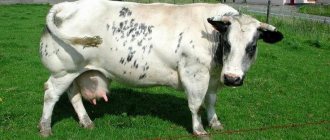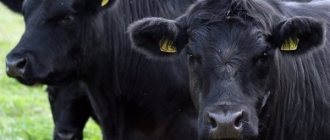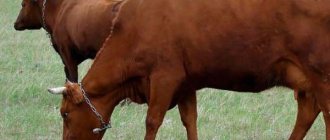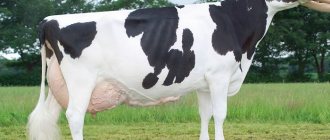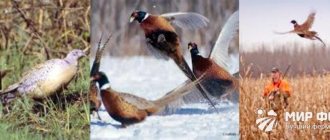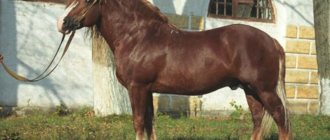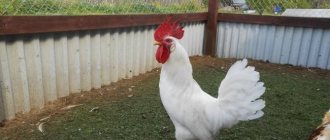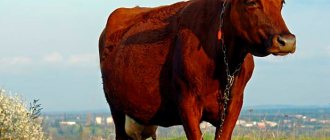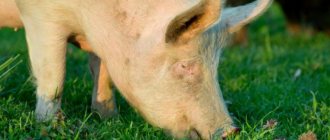Appearance and description of Holsteinized cattle
The Holstein breed of cows appeared due to the crossing of several species of individuals from European countries. The main breeding work was carried out at the beginning of the 19th century in the USA, when the American farmer W. Chenery bought himself a pair of black-and-white cows.
He was pleasantly surprised to notice the high-quality milk yield. Over the next years, the farmer improved this breed and developed a new one. From the beginning of 1980 to the present day, the breed is called Holstein, although some sources still mention the old name - Holstein-Friesian.
Reference. The weight of a Holstein cow starts from 600 and ends at 900 kg (heifers) and up to 1000–1200 kg (calves). The height of the female individual is 145 cm, and the male one is more than 1.5 meters. Newly born calves already weigh 40–45 kg.
The quality of dairy products directly depends on the living conditions of livestock. For example, an American cow can produce 8 tons of milk per year with a fat content of more than 3.5%. During the day, the milk yield of one cow can reach 70 kg of milk. In Israeli conditions, it is possible to produce about 10 tons of milk per year, with a fat content of up to 3%. In Russia and Belarus, a cow produces from 7 to 7.5 thousand kg per year. Fat content is about 4%. It is not for nothing that this breed is considered the most dairy breed in the world.
History and main characteristics of the breed
The original name of this breed of cows is “Holstein-Friesian”. The place of its occurrence is considered to be the northern regions of the Netherlands (Friesland and North Holland), as well as the northwestern part of Germany (Schleswig-Holstein). The breed standard was formed a long time ago: already in the 13th century, local cattle breeders kept animals of a characteristic black-and-white color and achieved impressive results in breeding for milk production.
In the first half of the 19th century, Holsteins were brought to the USA, where American farmers took up them. Unlike their European colleagues, they were not too strict about the exterior and did not cull individuals that had a red-motley color, due to the “work” of recessive genes.
Initially, the breed standard did not include a red-and-white color.
This allowed American enthusiasts to breed animals that produce record milk yields and have good “meat” characteristics, and obtain the breed that is now in demand in all countries of the world. Let's look at its generalized features in the table:
| Parameter | Characteristic |
| Animal | Cows (Bos taurus taurus) |
| Breed | "Holstein" ("Holstein-Friesian") |
| Productivity direction | Dairy (in domestic registration – milk and meat) |
| Live weight of adults | Females – 600-700 kg, males – about 900 kg |
| Height at withers | Females – 145-150 cm, males – up to 160 cm |
| Coat color | Variegated (black and white, less often red and white) |
| Age of puberty | 12 months |
| Milk productivity | On average 8-9 thousand kg during the lactation period |
| Milk fat content | From 3.1% to 3.8% |
| Slaughter yield of meat | 50-55% |
| Sustainability | To difficult conditions and stress - average |
| Year of registration in the State Register of the Russian Federation | 1993 |
| Originator | JSC "Head Center for the Reproduction of Farm Animals" |
Holstein bulls (pictured) can weigh more than 1 ton
Well-fed adult males are capable of gaining body weight of more than 1200 kg (on average 900 kg) with a height at the withers of about 160 cm. Females are a little more “graceful”: they weigh 600-700 kg with a height of 145-150 cm. The animals have a wedge-shaped body with wide pelvis and deep chest. The udder of females is well developed, large, elastic, with clearly visible veins. Most individuals are painted black and white, and the configuration of the spots is purely individual. Sometimes you come across both pure white and completely black specimens - this is not considered a deviation from the standard. With the help of American breeders, red-and-white cows are no longer culled. On the contrary, since 1971 they have been bred separately in an attempt to create a new breed line.
External characteristics and photos of black-and-white and other Holsteins
The breed is so unique that it can be recognized by its appearance. Holsteins have:
- Powerful, medium-muscular body.
- Volumetric lower back and narrow chest.
- Rough chest.
- Narrow neck.
- Strong joints in the legs.
- The udder is cup-shaped, covered with short white hair.
- Different colors, most animals are black and white, but black and white and red and white are also found. There are also white individuals with large black spots.
Below are photos of animals of this breed:
Advantages and disadvantages
This breed of cows has become widely known due to a number of advantages.:
- early puberty;
- clean;
- good immunity (with proper care);
- quick and good adaptation to a new place;
- quiet and calm attitude towards other inhabitants;
- trouble-free crossing with other breeds to increase productivity;
- excellent, high-quality products: milk, meat;
- quickly digest feed, that is, high milk productivity.
The favorite breed of farmers also has disadvantages:
- high cost of maintenance;
- in cold climates, milk yield becomes significantly less;
- require prevention and regular veterinary examinations;
- dependent on the conditions of detention.
Important! Adults have a hard time with a change of environment; for them it is a stressful situation. It is better to avoid this and buy or transport young animals.
Nutrition and care
Holstein cows are very picky and demanding in terms of nutrition and maintenance. In the conditions of Siberia and the northern regions of Russia, they almost never take root.
They require special hygiene standards and temperature indicators, they need regular cleaning and cleaning of the stall, bathing and fresh bedding.
On farms they are kept mainly in a free-stall system.
If these requirements are not met, animals experience a decrease in immunity. They may be exposed to infectious diseases.
Important: It is not recommended to transport adults. They do not tolerate transportation or any medical procedures well due to their high sensitivity to stress.
Any deviation from the usual conditions reduces the milk yield and weight of the animal.
These cows need an enhanced, balanced and varied diet.
In winter, their diet must certainly include corn, legumes, protein-rich meal, vitamins and minerals, root vegetables, silage, and high-quality hay. In summer, it is necessary to provide food with fresh grass and mixed feed.
The nature of the products that the animal provides
Productivity indicators of Holstein cows:
- The period when a cow is able to produce milk is called lactation, which lasts 305 days. The amount of milk milked varies. It depends on the location of the cow, nutrition and care.
- Sexual maturity in Holstein cows occurs at one year of age.
The first pregnancy lasts 2 years. A well-groomed cow can calve 2-3 times in her lifetime. Animals need to rest - this is the so-called dry period - to restore their strength. It lasts 50–70 days, taking into account the age and condition of the animal. Females cope well with the responsibility of bearing offspring. Translated into numbers, the following values are obtained: out of 100 fertilized individuals, 83–90 will give birth to calves. - Young bulls grow quickly, which makes it possible to use them as beef. In numerical terms, compared with meat production, the yield is small, only 50–55%.
A newly born bull weighs 35–50 kg. Within a year and a half, given proper care and nutrition, it gains weight to 245–500 kg. There is no point in keeping a bull with such weight. Those who are not chosen to reproduce are sent to slaughter.The resulting meat from 15-month-old bulls of this breed is very tender and lean. In the modern industry, this beef is considered dietary.
Origin of the Holstein cow breed
The historical homeland of the Holstein, or, as it is also called, the Holstein-Friesian breed, is considered to be the Netherlands (more precisely the regions of North Holland and Friesland) and the northwestern region of Germany Schleswig-Holstein. In these lands, cattle breeders for centuries have bred a breed of cows that would give good productivity, making do with the most accessible food resource possible - grass.
It is noteworthy that the breed developed almost exclusively through selection and breeding, without crossing with other breeds. According to available data, the black and white cow appeared in this region about 2 thousand years ago along with tribes of herders who migrated here. Constantly improving the characteristics of the population, but without mixing it with other breeds, Dutch cattle breeders achieved excellent results by the 13th century. The dairy boom, which was the result of progress in cattle breeding, allowed a significant increase in the production of cheese and butter, so since then Dutch cheeses have been considered one of the best in Europe.
Black-and-white Holstein cows were actively purchased by other European countries, especially Great Britain. Later, based on these cows, other well-known dairy breeds were created. However, the true international boom of the Holstein breed took place only thanks to the incredible achievements of North American farmers who adopted Dutch cows.
Strong interest in this breed in America appeared in the 1830s. Gradually, through the efforts of individual enthusiasts, the population of Holstein cows in the USA grew, and the productivity of herds increased.
It is noteworthy that in Holland itself, breeders paid a lot of attention not only to the milk characteristics of cows, but also to issues of color. At the same time, North American farmers completely ignored the color, focusing breeding efforts exclusively on the milk and meat productivity of Holsteins. That is why, over time, it was American rather than European cows of this breed that began to demonstrate the best results in terms of milk yield.
It is noteworthy that today two names for this breed are used in parallel - the Holstein cow and the Holstein-Friesian cow. Although by and large both names can be considered synonyms, there is still a certain difference between them. Holstein cows are usually called those cows that trace their ancestry to the North American population of this breed, while Holstein-Friesian cows are, accordingly, purebred Europeans. In practice, there is not much difference between them, so in what follows we will use both names as synonyms for the same breed.
Milk
The amount of milk production of a cow is determined visually by her chest and milk veins. A cow with only the right udder will be multimilk. The farmer or owner is responsible for the quality of milk, providing quality maintenance and nutrition.
Coat color can also describe milk production. Thus, black cows on an industrial scale produce 7.3 thousand liters per year with a fat content of 3.8%, red cows - 4.5 thousand liters per year with a fat content of 4%.
On farms, cows are milked by hand or using specialized machines , but the product yield is much less, only 6 thousand liters.
Attention! The udder nipples should not be allowed to be rough; they are small in size. It is advisable to use special fatty creams at each milking.
Calves
Features of the keeping include caring for calves.
This type of cow is picky about living conditions. Therefore, it is very important to monitor the health of these animals and their home. At the calving site, everything must be prepared, cleaned and disinfected for the birth of the newborn. In summer you can use a lawn, in winter you can use a specially prepared room heated with a disinfecting lamp. Another important condition is the presence of humidity.
Hygiene is of great importance in the first two weeks after birth, since the body is not yet strong and there is a high probability of infection. That is why you should never touch a newborn calf with undisinfected hands.
Breeding livestock
In the qualitative increase in the number of cows, the main role is played by males, since the calf inherits milk genes on the paternal line. Bulls are carriers of valuable genetic material. They are often used for crossing with different breeds. This is done to increase productivity. Breeding heifers for milk is quite profitable, but only if they are kept properly.
Cows can produce no more than 3 calvings during their life. Childbirth in this type occurs without complications. Newly born bulls quickly get on their feet and have a strong build. Caring for a male in his first days of life consists of feeding him milk and then introducing him to complementary foods.
Attitude to viruses
Holsteins have excellent immunity, which manifests itself in resistance to disease. They are very energetic thanks to a balanced diet. All these qualities are achieved with timely cleaning of the stall, since if hygiene standards are not observed, the risk of infectious diseases increases.
Dirt can cause diseases such as leptospirosis and necrobacteriosis. As soon as signs of infection appear, you should immediately contact a veterinarian for help. He will prescribe medications, the correct dose of antibiotics.
Important! If the cow is kept in drafty areas, there is a risk of developing mastitis.
Advantages and disadvantages
The popularity of the breed among farmers and private breeders is due to a large list of advantages:
- high milk yield;
- rapid adaptation to climatic conditions;
- strong immunity, which is reflected in resistance to diseases;
- cleanliness;
- intense weight gain;
- with large milk yields, the milk is fatty and contains a lot of protein;
- Despite the dairy direction, cow meat has excellent taste.
Farmers who are little familiar with the breed, but are planning to acquire bulls, should take into account that the cattle are considered expensive to care for. The best qualities of Holstein are manifested only under proper conditions of detention. The cleanliness of cows requires frequent cleaning. Stress is also contraindicated for animals, so transportation should be planned when they are growing up.
Among the main factors influencing the productivity of bulls are climatic conditions. The harsher the winters in the northern regions, the less milk the cow produces. Body weight gain also lags behind the average.
Holsteins require high-quality nutrition; good forage should always be included in the daily diet.
How to feed correctly at different times of the year?
A cow doesn't eat the same thing her whole life. Her diet should be varied. It depends on the time of year and is associated with physiological characteristics occurring in animals.
Dead period
The duration of dead wood is approximately 45–66 days.
During this period, the cow needs to prepare for calving. At this time, a diet containing highly succulent feed should be introduced with extreme caution. It's better to exclude them. A week before the calf is expected to be born, hay and silage are removed, and a couple of days before the calf is born, concentrates are abandoned. During the period when a cow does not produce milk, she needs to eat two to three times a day. This period is called netel.
Calving period
After the birth of the baby, the limited diet is stopped and hay of various types and mixed feed are reintroduced into the diet. Root vegetables should be added gradually, and silage should be added only after the colostrum formation process.
Lactation time
The lactation period in cows is divided into 4 periods:
- calving;
- milk;
- lactation;
- end of lactation.
Nutrition is selected according to each lactation period in order to provide the cow with the nutrients needed during a specific period.
How much does it cost and how to choose?
For those who want to purchase this breed of cow, you need to know that its cost is 270 rubles per kilogram of live weight. Price varies depending on region. The cost is also largely influenced by:
- body mass;
- place of purchase;
- natural line and appearance;
- color
Due to its high productivity, the Holstein breed has become widespread. Many livestock breeders choose this particular breed of cow. There are those who will engage in the resale of specific individuals.
Before purchasing cattle, their representative must be thoroughly examined. Condition and appearance should not raise unnecessary questions. There are a number of recommendations that it is advisable to take into account:
- If you want to save money, then you definitely need to buy from a private seller who is not responsible for the quality of your purchase. On farms the situation is completely different. They are responsible for the quality of each individual. Only healthy ones are put up for sale, the rest are discarded.
- You should pay attention to the conditions of detention and the cleanliness of the stall. The individuals themselves must be clean.
- Ask the owner who takes care of the cows. It is worth keeping in mind that a sudden change in diet can result in stress, which in turn can affect the individual’s weight gain.
- Read and ask about the place where you want to buy.
Appearance
— Advertising —
The Holstein breed is quickly recognizable due to its distinctive color markings. The description of the species states that it is a cattle with a color pattern that combines black and white or red and white. The animals have a dairy-type exterior: a wedge-shaped and deep body, wide shoulders and lower back. The udder is large, with pronounced veins.
A healthy Holstein calf weighs 42 kg or more at birth. An adult dairy cow weighs on average 710-720 kg and grows up to 150 cm in height.
Interesting observations from experienced farmers
If you are new to livestock farming, then it is advisable to get acquainted with the opinions of already experienced farmers. Some popular recommendations:
- Do not purchase adults. A change of environment or moving affects them like stress. It is better to opt for calves.
- Individuals with variegated colors are the best suited for fattening among Holstein cows.
- Cows should be fed exclusively with high quality feed in order to raise healthy offspring.
- Carry out a thorough inspection of the premises for the presence of drafts. If found, remove it immediately, as Holsteins are very sensitive to various types of wind blowers.
Holsteins are the best breed if you want a dairy cow. They have good adaptation to any conditions with proper care. They have strong immunity. These animals themselves are clean. They live relatively short lives.
During this short period, the maximum number of calvings is about 3. The main thing to understand is that these animals require close attention, care and love. Without this, the productivity of heifers and bulls will drop sharply.
Tips and tricks for livestock farmers
If you read on the Internet forums of livestock breeders specializing in this breed, you can find many recommendations. Most popular tips:
- for fattening, have Holstein cows of a motley color;
- buy calves rather than adults to avoid stress due to a sudden change in environment;
- carefully check the barn for drafts, to which the Holstein breed is very sensitive;
- feed animals with high-quality and properly selected products, which will help raise healthy cows.
Holstein cows are very productive, but at the same time they are demanding. These animals have an equal number of pros and cons; it is recommended that only experienced breeders own them.
